 By Pepper Parr
By Pepper Parr
December 1, 2014
BURLINGTON, ON
The report gets put out every year – the most recent is the third released by the Burlington Community Foundation. It is a snapshot of where we are with the issues the Foundation feels are important to the city.
This year the Vital Signs report gives more attention is given to transit and mental health as well as, surprisingly, culture.
In the 2014 update, independent research continues to confirm that Burlington is truly unique among mid-size Canadian cities. Employment rates, new community gardens, improved waste management programs and dropping crime rates are among the many great livability highlights of this year’s report .
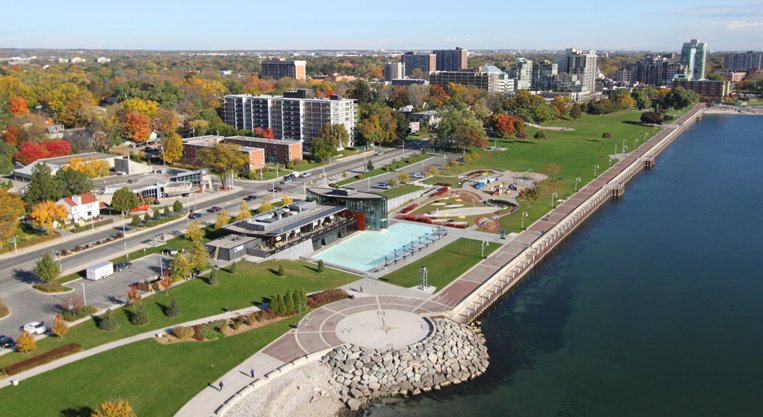
Are we a city “we can all feel at home in?” Not everyone can feel truly at home – we have some work to do.
As the BCF revisited 11 key areas of community life, a few areas with emerging issues were also uncovered. For instance, as our city becomes more built up, the city is experiencing more traffic, vehicle collisions and related property damage . There’s also a shortage of housing options. The current rental vacancy rate of 1 .9% is well below the 3% benchmark that is considered necessary for adequate competition and supply .
Established in 1999 as a centre for philanthropy, the Burlington Community Foundation exists today because local people had a clear vision for our city’s future .
Arts and culture:
The report suggests Burlington has a strong and diverse arts and culture scene; that should be seen as more of a wish. The arts have been a part of Burlington for a long time; culture is something that is emerging.
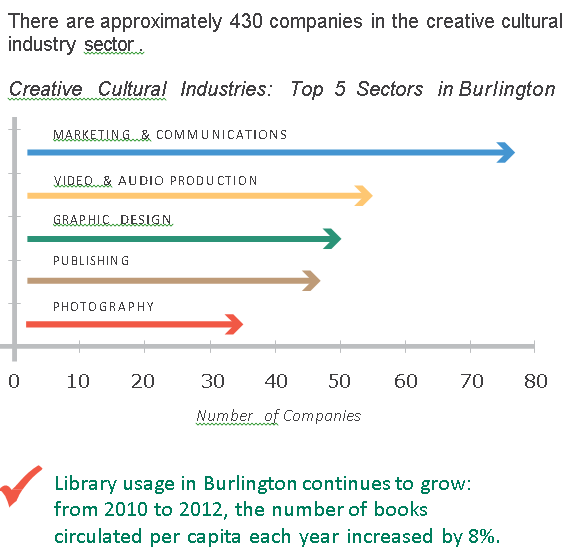
There are enough companies in the marketing field for the city to be seen as a place where good creative work can be done,
Vital Signs refers to a rich variety of cultural attractions that will engage people as “go to” places, accessible and affordable to all . Burlington will be home to and will showcase a wide variety of multicultural artists, spanning many types of art: from “traditional” art forms to emerging art forms .
“Burlington will be seen as a city that attracts, inspires, encourages and is home to creative thinkers.” We are not there yet.
If seen as part of the 20 years out projection a vision could have Burlington seen as an arts and culture travel destination: people will come to visit Burlington because of the quality and variety of its arts and cultural experiences within a context of recreational, retail, and culinary options. People come to Burlington now because of the geography and out festivals.
Anne Swarbrick, the Interim Executive Director, Art Gallery of Burlington hopes that the arts will be valued for their contributions to economic development and for the creative thinking and skills that they teach.
In a survey of Burlington residents, 76% said culture is “essential” or “highly important” in their daily lives. There are many types of cultural experiences. For Burlington residents, the top 6 are festivals (86%), museums and local history (81%), art galleries (78%), going to the theatre (75%), public art (69%) and family heritage and traditions (69%).
Burlington is home to 33 community cultural organizations, which together support:
624,000 visits to local festivals, events, productions and exhibitions, of which 535,000 visits are free to the public
89,000+ hours of cultural programming offered to all ages
650+ workshops
1,400+ residents engaging as volunteers.
Impressive numbers.
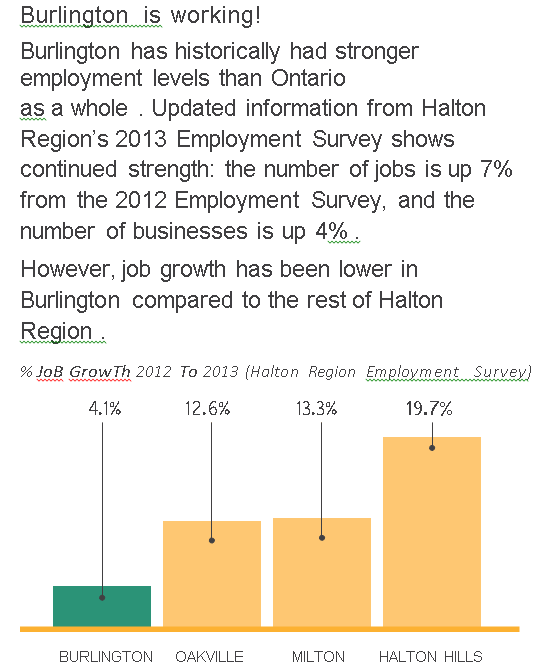
Burlington is not keeping up with the work force growth the Region is experiencing. Some research and analysis of this data is needed. who will do that research and analysis? Economic Development Corporation? Someone should do it.
Employment
The statistics the kind of employment available in Burlington is not as impressive. The Economic Development Corporation is constantly looking for companies they would like to see move to Burlington and create high added value and high paying jobs; the reality is that we are adding relatively low paying retail sector jobs in a city where apartment rents are higher than other communities in the GTA and rental availability is considerably below the standard
There doesn’t appear to be a strategy that will work. “Creating a high performance economy depends on the right blend of businesses, a highly qualified workforce, and motivated business investment”, says Mayor Rick Goldring. The Burlington Economic Development Corporation is taking a more direct, proactive and strategic approach for a short and long-term development strategy to retain and attract business. This strategy will be focused on creating a dynamic ecosystem conducive to business growth for Burlington’s long-term fiscal capacity, now and in the future.”
Statements like this amount to bafflegab – they say nothing.
Burlington has historically had stronger employment levels than Ontario as a whole . Updated information from Halton Region’s 2013 Employment Survey shows continued strength: the number of jobs is up 7% from the 2012 Employment Survey, and the number of businesses is up 4%.
However, job growth has been lower in Burlington compared to the rest of Halton Region. The types of jobs in Burlington are changing. Notably, in the 2012 Employment Survey, manufacturing was the largest sector by number of jobs, but in the 2013 survey it had dropped to second place behind the retail sector.
A portion of the Phase 2 Final Report on Employment Lands said: Over the next twenty years, a number of the conditions which underpinned the City’s past economic successes are expected to change.”
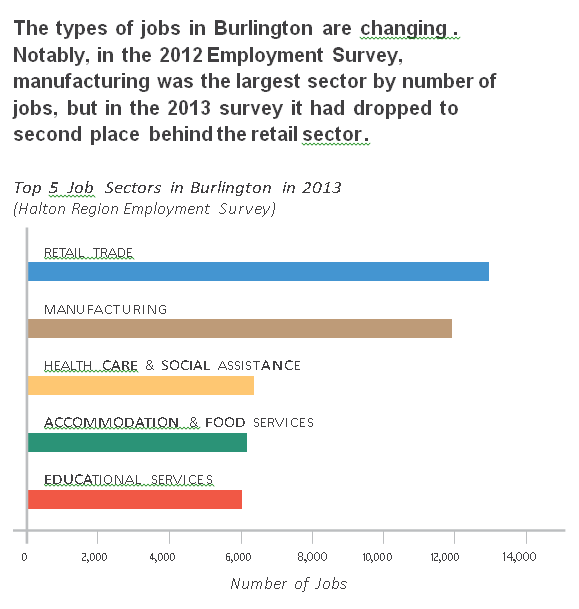
The drive for high quality well paying high tech jobs is not being reached; there are more people in retail now than in manufacturing – and Burlington isn’t exactly a shopper’s mecca.
“Ontario’s manufacturing-based economy has entered another period of transition, as manufacturers come to grips with increased global competition, changing patterns of foreign investment and an aging labour force. Fuel costs are rising and congestion on the 400 series highway network is increasing. Locally, the availability of land for new greenfield development is expected to become scarcer as Burlington approaches its build-out.”
That is not good news and suggests a significant re-think is needed as to what we want to be from an employment point of view is needed.
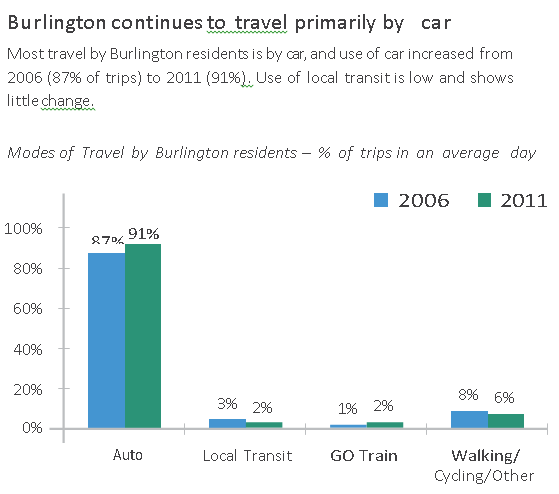
These are not good numbers. The city does not seem prepared to develop options that make it possible to travel by anything other than a car. Longer term this is very bad news for Burlington.
Transit and transportation:
The challenge of easing traffic congestion will increase due to population and employment; the call is for more use of alternate modes of transit. The people of Burlington don’t yet have any appetite for getting out of their cars
Build more roads ? – our options are limited: Widening existing roads or building new ones, in most circumstances, will encroach on private property, impact mature trees and green space or compromise the existing public spaces.
A more sustainable transportation strategy is to move more people per kilometer by walking, cycling, via transit using high occupancy vehicles.
15% of all trips within Burlington are by transit
30% of all eastbound trips leaving the city are by transit
10% of all westbound trips leaving the city are by transit
Sustainable local environmental practices
Burlington will have strong local food security and a strong local food economy. There will be significant local food production and processing.
Residents will have ready access to local food through farms, community gardens, farmers’ markets, grocery stores, and restaurants.
Neither of these is the case today
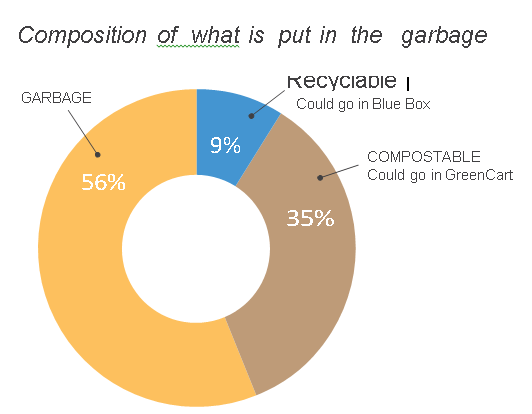
Lot’s of room for improvement here.
Michelle Bennett, Grow To Give Garden Coordinator, BurlingtonGreen Environmental Association, says the dream, the vision and provincial policy call for Burlington and Halton Region to protect its urban and rural green spaces, agricultural lands and woodlots . The Niagara Escarpment lands, flora, and wildlife have to remain preserved from greenfield development, expanded aggregate extraction and highway expansion.
Residents will be engaged and have as much say as developers, business and city planners in how land is used and developed in Burlington .
Burlington’s drinking water from Lake Ontario and groundwater aquifer sources will be clean and healthy for all.
Burlington will have a community energy strategy that effectively conserves energy use, emits less greenhouse gases, and is increasingly reliant on renewable sources.
These were correctly set out as dreams; it is going to take leadership and vision to make them a reality.
There are also competing interests at play; the people who own large swaths of land north of Dundas didn’t buy it to grow hay for horses.
A city where people enjoy the outdoors
Burlington has 1,472 acres of city-owned parkland, and the city each year takes care of 60,000 trees, plants 600 new trees, and maintains 796 acres of grass. Most residents are within a 10-minute or less walk from green space.
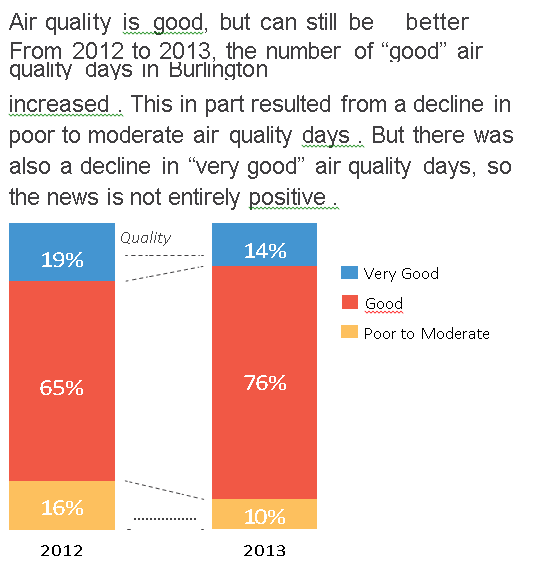
With steel plants across the bay – our air quality is surprisingly good.
Burlington operates three community gardens, two of which opened in 2014. “Community Gardens are shared spaces where people gather together to grow fruit, vegetables, and/or flowers collectively. Community Gardens provide health, economic, educational, social, and environmental benefits to participants and the community at large
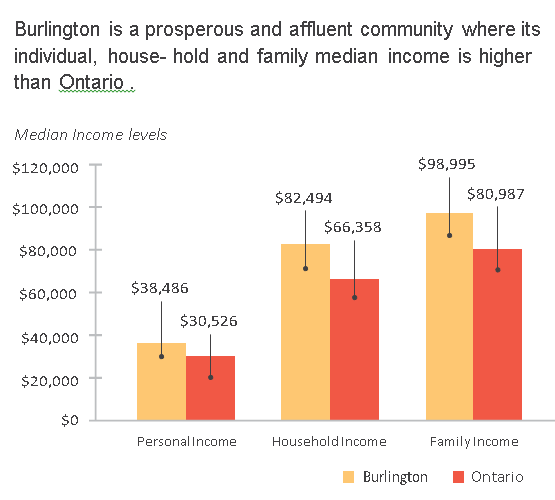
We are prosperous, we are generous. Are we going to be able to make the allowances for those that are not as well of? If the prosperous want cleaning ladies – they will learn to make the needed allowances.
Burlington is a giving community.
In 2010, 30% of Burlington tax filers reported charitable donations, which is higher than for Ontario as a whole (24.5%). Collectively, Burlington tax filers donated $63 million to charities. (Community Development Halton, Charitable Donations in Halton, Community Lens Bulletin #91)
Many renters experience financial difficulty
When compared to other Regional Municipalities in the Greater Toronto Area, Halton’s average monthly rent is the highest.
According to the Canada Mortgage and Housing Corporation, housing is considered affordable if shelter costs account for less than 30% of before-tax household income. If shelter costs exceed this threshold, it can become more difficult to afford other essentials such as food, clothing and transportation.
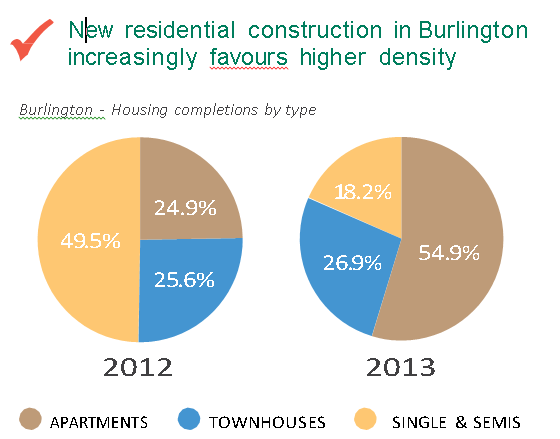
The data shows close to radical changes. Are we planning this type of change or is it what developers want to build and the city planners go along with the projects? Is this good planning? Does it reflect the Official Plan?
In Halton Region, over 41% of renters are spending more than 30% of their income on housing. The problem is even more severe among recent newcomers to Canada living in Halton, with 48 .5% spending more than 30% on shelter.
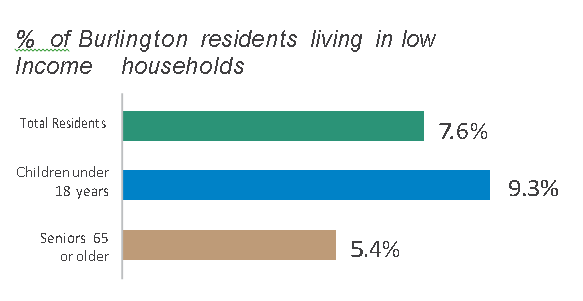
Are these numbers to be concerned about? Close to 20% of residents are part of a low income household.
Not only are rents high but there is a shortage of rental properties. The rental vacancy rate improved a bit from 1 .3% in 2012 to 1 .9% in 2013 . However, it is still well below the benchmark vacancy rate of 3% considered necessary for adequate competition and supply . It is also well below neighbouring Hamilton’s 3 .9% vacancy rate .
An application of community mobilization to policing – mental health:
“A lot of mental health issues have become policing issues because either there is no one else to call or they don’t know who else to call.” In the community mobilization approach, partnership with mental health organizations is critical.
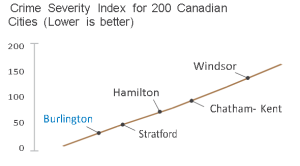
Burlington is a safe place to live. Is that because of superior policing or geography?
Halton Regional Police Chief Steve Tanner says “We will always be the emergency response for mental health where someone may be violent or when someone is suicidal. We will always have the intervention, but then we should very quickly be able to hand it over to people who can deal with it better on a long-term basis.”
Canada’s age profile is getting older and Burlington is one of the city’s leading this change. The trend will continue for several decades into the future. For example, the proportion of people 65+ years of age in Ontario is expected to grow from 14 .6% of the population in 2011 to over 23% by the year 2036 .
Burlington’s age profile has historically been older than that of Ontario as a whole, and the difference has been increasing over time . As of 2011, 16 .9% of Burlington’s population was 65 years of age or older, compared to 14 .6% of Ontario’s population
The Burlington Community Foundation concludes that: “Potential is a word that sums up our city’s future. As a prosperous and affluent community, individual, household and family median incomes in Burlington are higher than the Ontario average. We are in a very fortunate situation.”
Looking ahead, a broad mix of employment opportunities – including more highly-skilled, well-paying jobs – will enable even more people to work and live here.”
“It is anticipated that the growing local food movement and urban gardening will both have a very positive impact on sustainable local environmental practices. Our close connection to nature will only increase with more urban and rural green spaces being protected from Greenfield development and aggregate extraction.
“Increased recycling and reuse initiatives have already helped to reduce garbage. However, we still have a way to go as 44% of materials currently being put in household garbage bins could have been recycled or composted.”
With less land available, more families will move into high density structures – the Halton Region Official Plan calls for half of all new housing units to be town-houses or multi-storey buildings and 30% to be affordable or assisted housing. Moving away from traditional single family homes will require new solutions and ideas to help us maintain the sense of community and scale that we all enjoy.
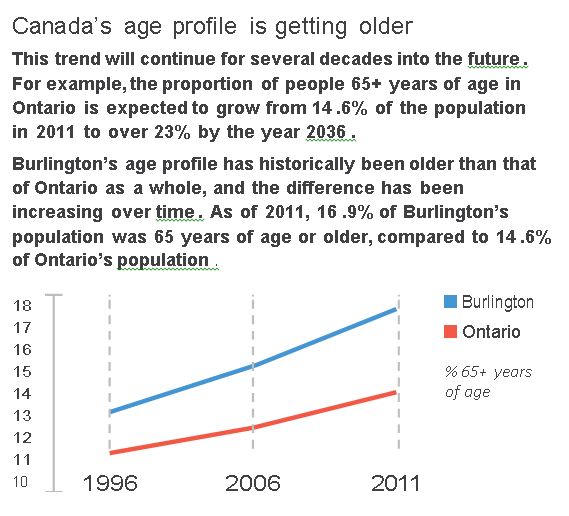
Does Burlington want to be a city of older people? Has our city council taken us in this direction or did it just happen? And is it good planning? More importantly, is it sustainable?
The demographics of our community have and will continue to change. With many boomers choosing to retire, a strategy to build stronger connections with millennials will be important. Young workers who establish work and family roots in our community are critical to ensuring a healthy and sustainable workforce. At the same time, a greater emphasis on community-based health care and supporting aging in place will assist our older residents who already face a shortage of long-term care facilities.
The 2013 Vital Signs identified an opportunity to improve mental wellness. In 2014, the Foundation organized three Roundtables to start conversations about mental wellness across our community. Leaders from mental health organizations, corporations and institutions, civic leaders, practitioners and community members, donors and fund holders as well as individuals who have experienced mental health challenges are all involved.
The next step is the creation of an action plan – supported by collaboration and community partnerships – to improve future mental wellness and mental health care in Burlington.
Collaborating with individual donors, public and private organizations to build endowments, give grants and connect leadership, the BCF is now the centre for philanthropy in the city. The 2014 Vital Signs report demonstrates the many opportunities Burlington has to continue to be a city that we can “all feel at home in.”
Related articles:
















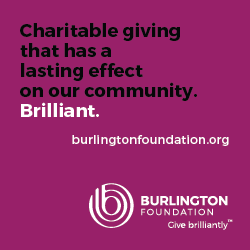




Thank you for your comments Joan. Conventional mathematical rounding rules were applied to the individual figures in the graph. Due to rounding, the figures may not add up to precisely 100%. As a result, a percentage between 99% and 100% is considered acceptable when reporting data based on percentages. We would be pleased to speak with you directly if you wish. I can be reached at BCF at 905-639-0744 x222. Kind regards, Colleen Mulholland
In reviewing this in the Transportation portion the percentages are short 1% in 2006 and 2011 has 101%. This is minimal percentage proving more checking by editors of article. Transportation in Burlington is needed to be more convenient, accessible and comfortable for the ever increasing older adults(seniors). Specialized transit needs accommodation for riders with comfortable riding vehicles. Frail elderly deserve better. Older adults have paid taxes continually. They deserve access to more vehicles at any time and any day.